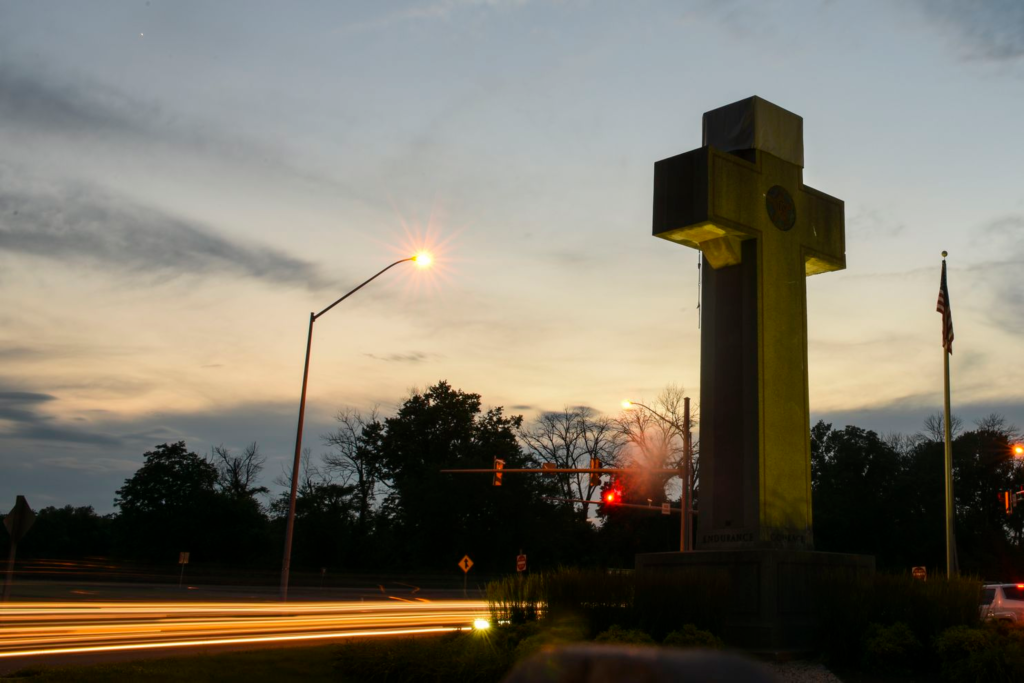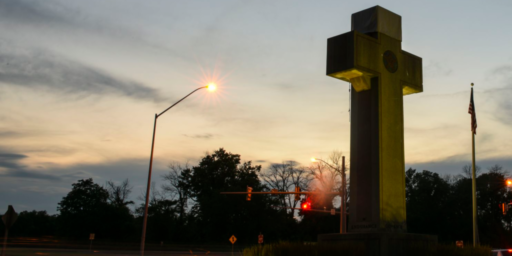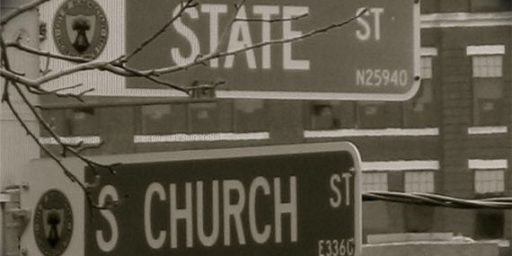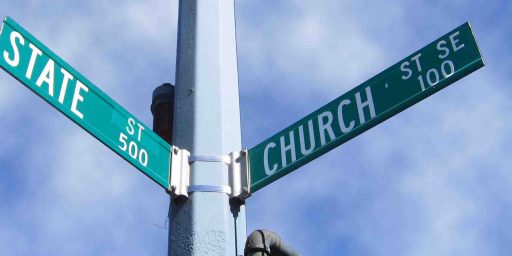Supreme Court Accepts Case Involving Maryland’s War Memorial Cross
There's a new church/state separation case on the Supreme Court's docket.

Late last week, the Supreme Court agreed to take up a case dealing with a war memorial that has stoked controversy due to the fact that it is cross set up in a highway median:
WASHINGTON — The Supreme Court agreed on Friday to decide whether a 40-foot cross on state property in suburban Maryland violates the First Amendment’s ban on government establishment of religion.
The case will give the court an opportunity to clarify its famously confused jurisprudence on government entanglement with religion. It will also allow the justices to continue a discussion about the meaning of crosses used in war memorials.
The cross at issue sits at a busy intersection in Bladensburg, Md., and commemorates 49 soldiers from Prince George’s County who died in World War I. It was built in 1925 using contributions from local families and the American Legion.
The state took over the monument and the land under it in 1961. Since then, the state has spent more than $117,000 to maintain and repair the memorial.
Several area residents and the American Humanist Association sued to remove the cross in 2014, saying they were offended by what they said was its endorsement of Christianity.
Last year, a divided three-judge panel of the United States Court of Appeals for the Fourth Circuit, in Richmond, Va., ruled that the cross sent an unconstitutional message of government approval of a particular religion, breaching the wall between church and state. The full Fourth Circuit declined to rehear the case by an 8-to-6 vote.
In urging the Supreme Court to hear the case, the American Legion and other supporters of the cross said the logic of the Fourth Circuit’s decision could imperil hundreds of war memorials that use crosses to honor the fallen, including the 24-foot Canadian Cross of Sacrifice and the 13-foot Argonne Cross, both in Arlington National Cemetery.
“No other court,” their petition seeking review said, “has gone so far as to hold that a longstanding, historical war memorial that was built to be a war memorial and has only ever been a war memorial was unconstitutional merely because its private builders chose to use a cross to honor their fallen loved ones.”
A separate petition from state officials, referring to the monument as the Peace Cross, said the appeals court had committed a disturbing error.
“The Peace Cross has stood as a place of solemn commemoration and a source of civic unity for nearly a century,” the petition said. “By compelling its removal, destruction or dismemberment, the panel’s decision will necessitate an act of shocking disrespect for the brave souls of Prince George’s County who died fighting for their country in World War I.”
In a brief urging the justices to deny review, the challengers said the memorial honors only Christian veterans, not all of whom welcome the use of a cross in this context.
“The Fourth Circuit’s decision,” the brief said, “not only advances religious liberty and equality for non-Christians, but also advances religious freedom for Christians, as many Christians believe the cross’s sacred status is denigrated when the government co-opts it as a symbol of war.”
The Washington Post has more:
The Supreme Court agreed Friday to decide whether a 40-foot cross in the median of a busy suburban Maryland highway is a secular memorial to those who died during World War I or an unconstitutional government endorsement of religion.
The Peace Cross, made of granite and cement, was built in 1925 as a tribute to local men who died during World War I. It was paid for by local families, businesses and the American Legion. But the giant cross sits on a piece of land that has been owned since 1961 by a state commission that pays for its maintenance and upkeep.
The challenge to the 93-year-old cross began with the American Humanist Association, a nonprofit atheist organization that has filed similar lawsuits throughout the country. In September, the group won a similar case in which it sought the removal of a 34-foot-tall cross displayed in a city-owned park in Florida.
The high court has sent mixed messages when it comes to public displays of religion, allowing some monuments with religious content to stand while rejecting others.
In Maryland, U.S. District Judge Deborah K. Chasanow ruled in 2015 that the cross could remain, calling it a historically significant and secular war memorial.
She said there is no indication that the Maryland-National Capital Park and Planning Commission’s maintenance of the cross “is driven by a religious purpose,” adding “the evidence of the commission’s secular purpose is uncontroverted.”
But a divided three-judge panel of the U.S. Court of Appeals for the 4th Circuit in Richmond disagreed, finding the cross on public land an unconstitutional government endorsement of religion.
The appeals court ordered the commission to remove, relocate or redesign the memorial.
Even though there are nonreligious elements in the monument, “the sectarian elements easily overwhelm the secular ones,” wrote Judge Stephanie D. Thacker.
“The cross is by far the most prominent monument in the area, conspicuously displayed at a busy intersection,” she wrote.
As a matter of law, this type of case strikes me as being of a similar nature of others involving some citation of religion in official government actions. The most notable example of that, perhaps, are the cases where the Supreme Court has dealt with the issue of prayers opening legislative sessions. that issue first came up in a 1983 Supreme Court case called Marsh v. Chambers in which a member of Nebraska’s unicameral state legislature challenged the constitutionality of both the practice of opening each day’s session with a prayer and the fact that the state was paying for the chaplain with taxpayer dollars. The U.S. District Court Judge that first heard the case held that an opening prayer did not violate the Constitution, but that state support for the position and the office did. On appeal, the Eighth Circuit Court of Appeals ruled that both practices were unconstitutional due to the fact that they violated the Establishment Clause of the First Amendment. In its opinion, the Supreme Court overruled the Eighth Circuit in a 6-3 ruling that relied mostly on the history I make note of above and did not address the constitutional arguments raised by the challengers. Instead, the Court essentially said that, like the practice of putting “In God We Trust” on currency, the practice of having a chaplain deliver prayers at the start of a legislative session, and making that a position paid for out of taxpayer funds, was at best a de minimis violation of the Establishment Clause.
The issue came up again in 2014 in Town of Greece v. Galloway where the Supreme Court dealt with the practice by the town of Greece, New York to open each meeting of its Council with a prayer, a practice that was challenged by a town resident assisted by civil liberties organizations. In a 5-4 ruling, the Court sided with the town and largely follow the precedent set in Marsh. As I noted at the time the court accepted the case, this seems like the ideal ruling in a case like this:
Some government practices that reference religion, I would argue, fall into a de minimis category where it’s recognized that some practices are essentially so harmless that they ought to be permitted as a general rule so long as they don’t become overtly sectarian. One example of that is the whole issue of the inclusion of the words “Under God” in the Pledge of Allegiance, or the appearance of “In God We Trust” on paper currency and coins. As a general rule, there doesn’t seem to me to be anything inherently coercive about either practice. Nobody, including schoolchildren, is legally required to recite the Pledge, and nobody can be legitimately punished for refusing to do so, or for refusing to say “Under God” if they day. Similarly, while we all use coins and paper bills at some point, I doubt anyone pays much attention to what’s written upon them beyond the denomination. Lawsuits challenging both of these practices have been routinely rejected by Federal Courts in no small part because of these facts.
As a general rule, I’d suggest that the idea of opening a legislative session with a prayer falls into this de minimis category in most cases. The prayers that open the House and Senate, for example, are usually fairly general to the point where they can’t be said to be representative of any particular religious tradition beyond, of course, an appeal to a God of some kind. It’s also worth noting, as the Supreme Court did in Marsh, that the practice of opening a legislative session with some kind of prayer has a long history in the United States. Indeed, at one point during the Convention of 1787 when delegates found themselves at an impasse over the drafting of the Constitution, it was Benjamin Franklin, who was, at best, a Deist, who suggested that the body engage in a short prayer. Additionally, the Supreme Court itself opens with the appeal that “God save the United States and this Honorable Court.” Given that history, it seems difficult to argue that those who drafted and ratified the First Amendment intended to ban a practice they themselves engaged in both before and after the Bill of Rights were ratified. Of course, this whole issue becomes arguably problematic when you’re talking about the fact that there are atheists and agnostics in the world, I’m not entirely convinced of the argument that the practice in and of itself is so inherently wrong that it ought to be prohibited for this reason alone. And I say this as someone who considers themselves to be an atheist.
This conclusion seems to be the same in this case dealing with the war memorial. The use of crosses in war memorials is not unprecedented. Indeed, there are military cemeteries around the world filled with row after row of crosses, Stars of David, or grave markers that have an appropriate religious symbol on them depending on the faith of the person buried there. No serious person can contend that this constitutes an endorsement or promotion of religious faith by the government. Similarly, I think that this memorial falls into a similar de minimis category along with legislative prayer and the other issues I’ve mentioned.
This isn’t the first case of its type that the Supreme Court has taken up. In Salazar v. Buono 559 U.S. 700 (2010), the Court dealt with a war memorial called the Mojave Memorial Cross that was erected by the Veterans of Foreign Wars in a National Park in the Mojave desert in 1934. Since the cross was on Federal land, the Plaintiffs in that case, much like the Plaintiffs in this Maryland case, argued that permitting it to stay amounted to an impermissible government endorsement of Christianity in violation of the First Amendment. In a divided opinion, the Justices ended up with a ruling that allowed the cross to stay on Federal property but which also remanded the case to the lower courts for resolution of other issues. To this day, it appears that those issues remain unresolved, but the memorial cross remains standing. Because of the divisions in the court, there was no clear-cut majority opinion even though the majority result allows the cross to remain standing. In a plurality opinion that was joined by Chief Justice Roberts and Justice Alito, though, Justice Kennedy stated that ”A Latin cross is not merely a reaffirmation of Christian beliefs,” he wrote, ”It evokes thousands of small crosses in foreign fields marking the graves of Americans who fell in battles, battles whose tragedies would be compounded if the fallen are forgotten.” Finally, in holding that not every apparent use of religious symbolism by or on government property, Kennedy stated that “The goal of avoiding governmental endorsement [of religion] does not require eradication of all religious symbols in the public realm.” In his dissent, though, Justice John Paul Stevens rejected Kennedy’s take on the issue. Instead, he argued that”[t]he cross is not a universal symbol of sacrifice….It is the symbol of one particular sacrifice, and that sacrifice carries deeply significant meaning for those who adhere to the Christian faith.”
Much has changed on the Supreme Court since the Salazar decision, of course. Justice Stevens has been replaced by Justice Elena Kagan, Justice Scalia has been replaced by Justice Gorsuch and, of course, Justice Kennedy has been replaced by Justice Brett Kavanaugh. This would seem to solidify the conservative wing of the Court, which arguably would mean that the Justices are likely to be sympathetic to the arguments made by the State of Maryland in favor of allowing the cross to remain in place. Until the case has been fully argued and briefed, though, it’s hard to guess which way the Court may come down in this matter, but my guess is that in the end, the Justices will find, as they have in the case of legislative prayers, that this is a de minimis expression of religion that does not really amount to an endorsement of any particular faith by the government, thus allowing the cross to stay.
Since the case has just been accepted, it has not been set for oral argument yet, but it’s likely that will take place sometime early next year. In the meantime, you can find more information about the case at the SCOTUSBlog information page.
Photo via The Washington Post




Place me in this category as well. This strikes me as fundamentally different in intent (not to mention semiotics) from things like placing the 10 commandments within a courthouse or a nativity display on government property.
I’m an atheist and I have no problem with the bullshit ‘Ceremonial Deism’ excuse. Fine. Whatever. I’m more focused on people abusing gay teenagers with conversion pseudotherapy and keeping the abortion rate high by prohibiting sex ed, and other much worse moral crimes.
There are 49 people it honors. That’s a pretty small number. Were any of them Jewish, Muslim or Militant Atheists? Do the families have a complaint?
Sometimes dead people happen to have been Christian. If it’s an existing monument, and historically accurate, I don’t have a problem with it.
If this were a new monument for people killed in the synagogue shooting in Pittsburg, and it was a giant cross, that would be bad.
Conversely, if there is a government funded or maintained monument for the victims in Pittsburg, it would be offensive if it didn’t have a Star of David.
@Teve:
Opening city council meetings with a Christian prayer is kind of a dick move. It’s not the worst thing ever, but it sends a clear message that they aren’t representing their entire constituency, just the Christians.
I think the Court is just wrong on this.
@Gustopher: Oh it’s totally a dick move. Like fighting so that everyone’s coins or license plates say In GOD We Trust, like here in florida. But a big percentage of American christians are those kinds of dicks. It doesn’t bother me much, compared to the much worse harm they cause people when the issue is gays and ‘Bortins.
@Gustopher:
I think in some places there is an opportunity for other faiths to deliver a prayer or invocation.
The Satanic Temple(*) tends to get involved in these a lot. I like them. They hit upon the brilliant idea of forming a religious organization based on a symbol offensive to the majority religious groups, and demanding equal treatment and representation along with other religions. They’ve also offered to place Satanic monuments in public spaces, as balance to Christian monuments in such spaces.
(*) It’s just a name. It’s not really a temple.
@Kathy: A group of Satanists got permission to do the invocation at a high school football game in Washington State (I believe) last year. One of the students made the request. So far, no requests from students who are Islamic, Hindu, or Buddhist though. But maybe those students don’t go to football games.
I think cases like this trivializes and undermines the important constitutional questions of Government establishment of religion. Principally, the litigants are engaged in a kind of douchebaggery against these very real memorials. Accomodation is not the same as establishment.
BTW, national cemeteries allow all kinds of religious symbols on grave stones.
https://en.wikipedia.org/wiki/United_States_Department_of_Veterans_Affairs_emblems_for_headstones_and_markers
Personally, as a birder, I like the Sandhill Crane
@Just nutha ignint cracker: Muslims, Hindus and Buddhists might not want to deal with angry Christians being all angry about someone reading an infidel prayer.
I’m betting it was a white guy who read the Satanic Prayer. It’s easier to make a principled a stand as a white guy.
If they lose, a clever town might change the memorial to a monument about the court case, leaving up the original giant cross as “educational”. Just add a pillar with a plaque describing the case, and the outcome.
A monument about the changing interpretations of separation of Church and State from the 1920s until now.
I’m not even sure I wouldn’t approve.
@Scott: Radically different to accommodate the religion of dead soldiers on their own graves, than to spend taxpayer money to put up a religious symbol on public ground to commemorate many dead. This case is more muddled, as it is an existing memorial that was given over to the local government, who now maintains it. But it is still radically different from veterans’ graves.
One is accommodating the religious beliefs of those who died. One is the government making a public statement with religious intent and goals.
I would posit that the fine folks who are foisting their religious symbols onto public spaces are engaging in douchebaggery. It’s not the largest problem in America, but I don’t have a lot of sympathy for the town.
@Gustopher:
This. Although, importantly, the state did not erect this monument.
(Does anyone else find it ironic to invoke de minimus on a 40-foot granite and stone colossus?)
There was clearly no problem here until the state chose to acquire the land the cross stood on. The proper solution is for the state to divest itself of that land. Those who wish to preserve the cross may do so, by purchasing the land it stands on and paying for its maintenance.
@DrDaveT:
Yep.
In my mind, everything hinges on this fact, the fact the monument has stood for such a long time (including a long time prior to acquisition), and the intent of the marker (which was as a memorial). At one point is something’s religious function emptied and it transitions to fundamentally being a historical marker?
My feeling is that this is a case where finding that this is a violation of the first amendment is getting into legitimately dangerous slippery slope territory (which I could see eventually applied against, for example, native american sacred sites that also reside on public lands).